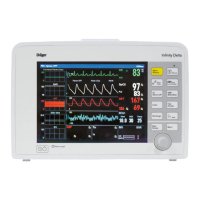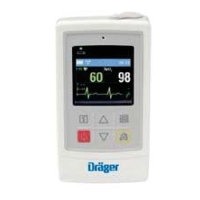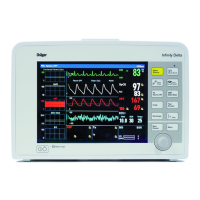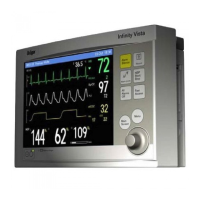Page 8-2 Infinity Gamma Series VF4
Overview
The monitor can:
! Display one or two ECG leads.
! Calculate the average heart rate per minute.
! Identify a number of arrhythmia events, including asystole,
ventricular fibrillation, bradycardia, and ventricular tachycar-
dia (see the chapter Arrhythmia).
! Analyze ST segment deviations for the displayed ECG leads
(option -- see the chapter ST-Segment Analysis).
Electrodes applied to the patient’s chest pick up the electrical
impulses initiated by the heart. The monitor amplifies these elec-
trical signals and displays them on the screen.
The monitor accepts 3, 5, and 6-lead ECG cable sets. With a 3-
lead set you can monitor the leads I, II, and III. With a 5-lead set
you can monitor the leads I, II, III, aVR, aVL, aVF and V (chest).
With a 6-lead set you can monitor the leads I, II, III, aVR, aVL,
aVF, V (chest) and V+ (additional chest).
When you first turn on the monitor, it calculates heart rate within
15 seconds or 3 beats, whichever is longer, and displays the value
in the HR parameter box. Thereafter, the heart rate is updated
after every detected beat. The heart symbol ♥ pulsates with every
detected QRS complex. When the HR alarm is turned off, a
crossed bell appears beside the HR value. When monitoring a
paced patient, the letter “P” is added to the heart symbol.
NOTE: If voltage to the monitored ECG lead(s) is too high, the
waveform goes blank until the input voltage returns to a range that
can be monitored.

